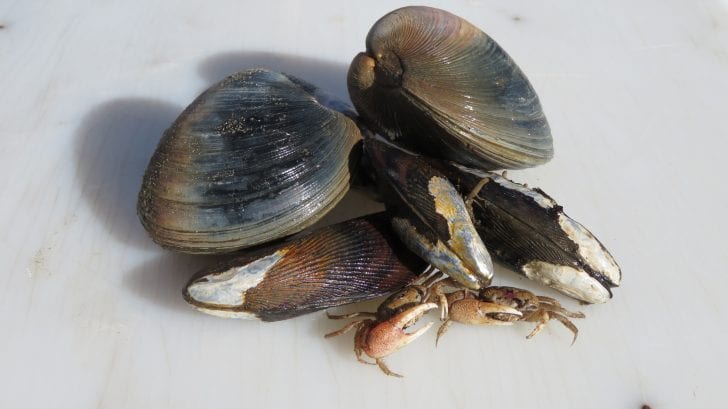Sheepshead, also known by the nickname “the Convict,” is an inshore species of fish that is well known to a lot of experienced inshore anglers, but for those of you who are not familiar with this black and white striped critter, please allow me a moment to fill you in on the details.
Sheepshead is a fish that primarily dines on crustaceans. Its diet will largely consist of juvenile Stone Crabs, white Shrimp, Mud Crabs, Fiddler Crabs, Sand Fleas, Mussels, Barnacles and Oysters.
The most popular bait used to catch Sheepshead is live Shrimp, Fiddler Crabs, Mussels, Clams out of the shell and Oysters out of the shell.
These fish are commonly found feeding along jetties, dock pilings, bridge footers and pier pilings or footers, and of course, along any large group of structure found in the water that has a healthy population or decent growth of crustaceans.
These wonderful fish can be found year-round in the Lowcountry
These wonderful fish can be found year-round in the Lowcountry, so what makes Winter Sheepshead so desirable? Sheepshead are not larger or not found easier in the Winter than in the Summer.
The issue with fishing for Sheepshead in the Summer is the other species of fish that feed in the same locations as Sheepshead.
Species like the Box Fish, Southern Puffer, Smooth Back Puffer, Oyster Toad Fish, Pin Fish, Black Sea Bass and more.

These species tend to be more aggressive and move faster through the water during their scavenger hunts for food, so when the fisherman lowers his bait into the water using say a Fiddler Crab, he will in most cases feel a strike quickly.
But usually it will be one of these smaller fish listed above, making it hard to find that large Sheepshead even though there is most likely one close in the vicinity.
During the Winter these other species of fish I mentioned tend to move out to deeper water leaving a lot of the Sheepshead behind. This allows the angler to target the Sheepshead easier without as many interruptions by those other species of fish.
It’s almost like he knows you’re there, he knows you’re trying to catch him
What else makes Sheepshead so attractive to a lot of inshore anglers? Sheepshead are well known for their stealth—their ability to remove the bait from your hook without the angler seeing or feeling a thing.
This really generates a contest between the angler and the fish, sort of a challenge between him and his opponent. Hahaha! Opponent? Seems funny, doesn’t it? But Sheepshead is just that.
It’s almost like he knows you’re there, he knows you’re trying to catch him, and his goal is to take as much bait as he can without being hooked. Your goal is to time his strike and set that hook before he runs off with your bait.
Some anglers will become frustrated. They will either fish more intensely, or they will quit, but I will try to help you with a technique that works well for me. First, there are a number of rigs that anglers will use for Sheepshead.
One will be a plain bottom rig, another will be a shallow water rig, but I find the Carolina rig to be the most successful. I tend to use a light egg weight, usually around ½ ounce to ¾ ounce, depending on the location’s currents.
I use around 12 inches of 20-pound test fluorocarbon leader line and a number 2 or 4 Octopus hook. For bait I like to stick to the Lowcountry favorites—Fiddler Crabs, Clams out of the shell, Mussels and Oysters.
I will drop my line down but close to structure where the Sheepshead will roam and search for food. I primarily keep my rod in my hand so I can feel the fish’s delicate strikes as it investigates and feeds on the bait. You will notice a very soft pull on the line.
The trick is not to set the hook or keep the line too taut. The trick is to slowly lower your rod tip, allowing your bait and line to be pulled down lower by the fish as the fish feeds.
When this occurs, instead of the Sheepshead being able to pull the bait from your hook, the Sheepshead, when pulling on your bait, will engulf the hook as well. In just a few seconds, you will then feel the line tighten as you’re leaning forward.
Sheepshead are powerful and love to fight
This is the indication that the Sheepshead fell for your technique, and just as the line tightens, you set the hook, but be ready for a vigorous fight by the fish.
Sheepshead are powerful and love to fight on their side and use currents to their advantage with their wide bodies grabbing a lot of water, making a six-pound fish feel like they are 12 pounds.

Move your rod accordingly to guide the fish away from the structure or debris in the vicinity. They will try to wrap your line around the debris. They will look for crevices and places to hide during the fight.
Your job will be to pull them away from these locations, and if done successfully, you may catch yourself a jail bird, a convict, a Sheepshead!
Once you have, you may find yourself, regardless of the cold, regardless of the weather, bundled up this Winter with a runny nose, red ears and a shiver that won’t go away, but it won’t stop the angler that has become addicted to the game between the angler and a Sheepshead.
I hope these tips from my experiences will be helpful to you, and like I always say, good luck out there and have fun fishing! To view some fishing adventures, go to my “Fishing with Jiggin’ Jerry” Channel on YouTube or go to www.jigginjerry.net.
You may also enjoy reading Going after the Reds by Jiggin Jerry





